中职英语基础模块1 Nice to Meet You
- 格式:pptx
- 大小:2.76 MB
- 文档页数:66
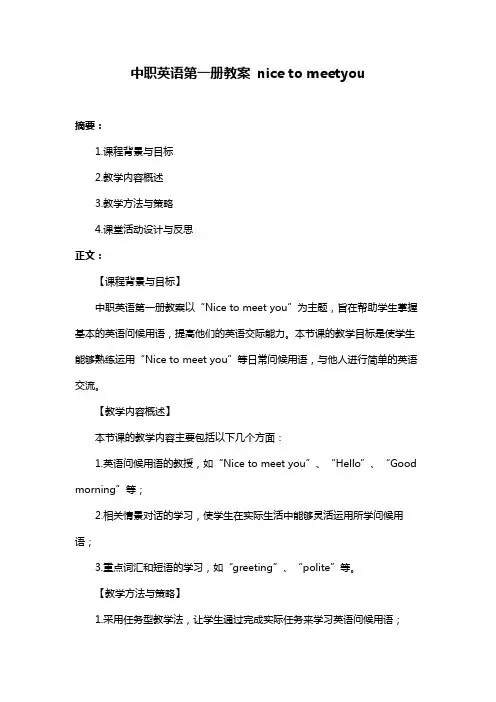
中职英语第一册教案nice to meetyou摘要:1.课程背景与目标2.教学内容概述3.教学方法与策略4.课堂活动设计与反思正文:【课程背景与目标】中职英语第一册教案以“Nice to meet you”为主题,旨在帮助学生掌握基本的英语问候用语,提高他们的英语交际能力。
本节课的教学目标是使学生能够熟练运用“Nice to meet you”等日常问候用语,与他人进行简单的英语交流。
【教学内容概述】本节课的教学内容主要包括以下几个方面:1.英语问候用语的教授,如“Nice to meet you”、“Hello”、“Good morning”等;2.相关情景对话的学习,使学生在实际生活中能够灵活运用所学问候用语;3.重点词汇和短语的学习,如“greeting”、“polite”等。
【教学方法与策略】1.采用任务型教学法,让学生通过完成实际任务来学习英语问候用语;2.通过角色扮演、小组讨论等形式,让学生在实际情景中运用所学知识;3.教师引导学生进行自主学习,鼓励他们积极参与课堂讨论,提高他们的自主学习能力。
【课堂活动设计与反思】1.导入环节:通过播放英文歌曲或进行英语游戏,调动学生的学习兴趣;2.讲解环节:教师详细讲解“Nice to meet you”等问候用语的用法;3.练习环节:学生进行角色扮演,模拟实际生活中的英语问候场景;4.总结环节:教师对学生的表现进行点评,总结本节课的学习重点和难点;5.作业布置:学生仿写英语情景对话,运用所学问候用语;6.教学反思:教师针对学生的学习情况,调整教学策略,提高教学效果。
通过以上教学方法和策略,学生能够更好地掌握“Nice to meet you”等英语问候用语,提高他们的英语交际能力。
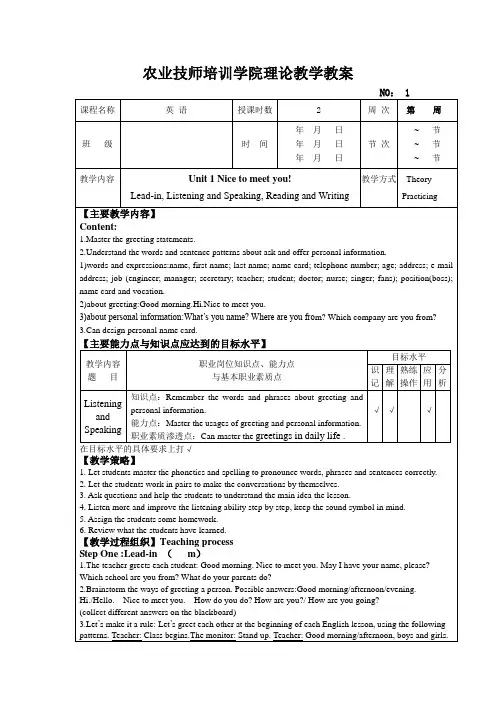
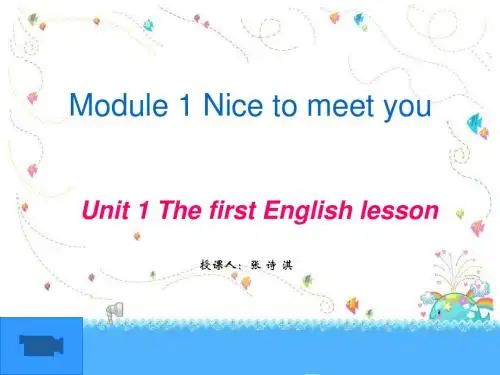
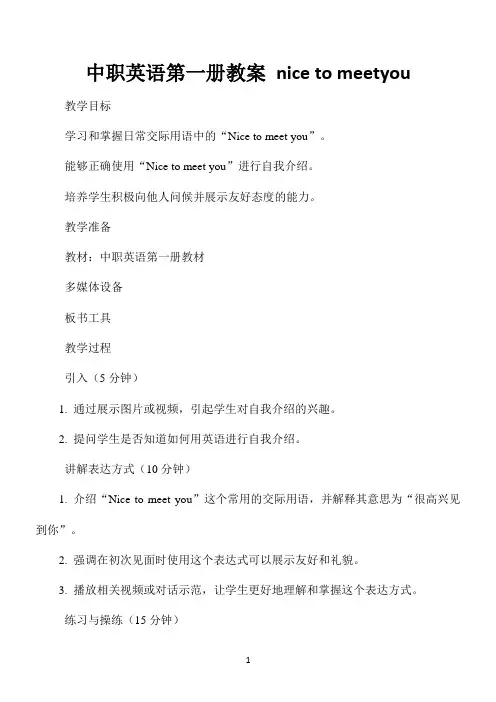
中职英语第一册教案nice to meetyou 教学目标学习和掌握日常交际用语中的“Nice to meet you”。
能够正确使用“Nice to meet you”进行自我介绍。
培养学生积极向他人问候并展示友好态度的能力。
教学准备教材:中职英语第一册教材多媒体设备板书工具教学过程引入(5分钟)1. 通过展示图片或视频,引起学生对自我介绍的兴趣。
2. 提问学生是否知道如何用英语进行自我介绍。
讲解表达方式(10分钟)1. 介绍“Nice to meet you”这个常用的交际用语,并解释其意思为“很高兴见到你”。
2. 强调在初次见面时使用这个表达式可以展示友好和礼貌。
3. 播放相关视频或对话示范,让学生更好地理解和掌握这个表达方式。
练习与操练(15分钟)1. 分组练习:将学生分成小组,让每个小组成员轮流模拟自我介绍的场景,使用“Nice to meet you”进行问候。
教师可以提供一些提示句,如“Hello, my name is [姓名]. Nice to meet you.”。
2. 整体练习:邀请几位学生上台模拟自我介绍的场景,全班共同回应“Nice to meet you”。
拓展应用(10分钟)1. 引导学生思考并讨论,在哪些场合可以使用“Nice to meet you”这个表达方式。
2. 学生分角色扮演不同场景下的自我介绍对话,并使用“Nice to meet you”进行问候。
3. 鼓励学生创造更多的交际用语和问候方式,以展示友好和礼貌。
总结与反馈(5分钟)1. 对学生进行简单总结,强调“Nice to meet you”的重要性和正确使用方法。
2. 提问学生对本节课所学内容的理解和掌握情况。
3. 解答学生可能存在的问题,并鼓励他们在日常生活中多加练习。
作业1. 要求学生写一篇短文,介绍自己并使用“Nice to meet you”进行问候。
2. 鼓励学生在日常交流中多次使用“Nice to meet you”,并记录下实践的情况。
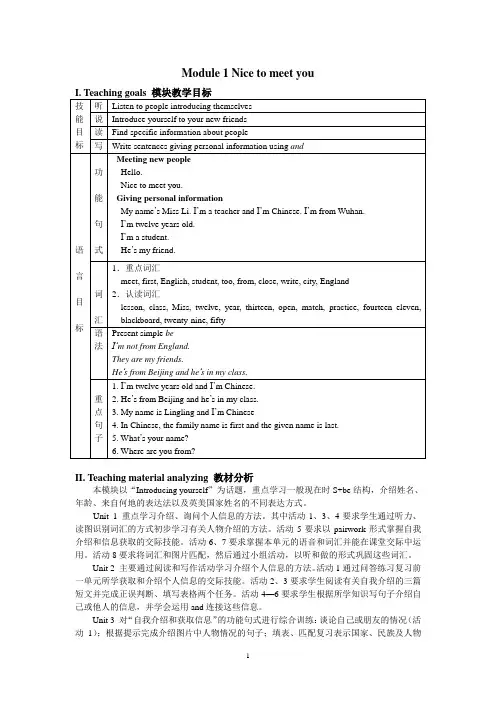
Module 1 Nice to meet youII. Teaching material analyzing 教材分析本模块以“Introducing yourself”为话题,重点学习一般现在时S+be结构,介绍姓名、年龄、来自何地的表达法以及英美国家姓名的不同表达方式。
Unit 1 重点学习介绍、询问个人信息的方法。
其中活动1、3、4要求学生通过听力、读图识别词汇的方式初步学习有关人物介绍的方法。
活动5要求以pairwork形式掌握自我介绍和信息获取的交际技能。
活动6、7要求掌握本单元的语音和词汇并能在课堂交际中运用。
活动8要求将词汇和图片匹配,然后通过小组活动,以听和做的形式巩固这些词汇。
Unit 2 主要通过阅读和写作活动学习介绍个人信息的方法。
活动1通过问答练习复习前一单元所学获取和介绍个人信息的交际技能。
活动2、3要求学生阅读有关自我介绍的三篇短文并完成正误判断、填写表格两个任务。
活动4—6要求学生根据所学知识写句子介绍自己或他人的信息,并学会运用and连接这些信息。
Unit 3 对“自我介绍和获取信息”的功能句式进行综合训练:谈论自己或朋友的情况(活动1);根据提示完成介绍图片中人物情况的句子;填表、匹配复习表示国家、民族及人物活动的词汇。
Around the world了解中西人名的不同;Module task要求通过问答形式介绍自己和他人。
III.Class types and periods 课型设计与课时分配Period 1 Vocabulary (Unit 1: 1, 2, 6, 7, 8)Period 2 Reading (Unit 1: 3, 4, 5; Unit 2: 1, 2, 3)Period 3 Integrating skills (Unit 2: 4, 5 6; Unit 3)IV. Teaching plans for each period分课时教案Period 1 VocabularyLanguage goals 语言目标1. Key vocabulary 重点词汇meet, first, English, student, too, from, close, write2. Key structures 重点句式I’m …He’s …We’re …Ability goals 能力目标Enable students to introduce themselves.Teaching methods 教学方法Listening and speaking.Teaching aids 教具准备Tape recorder, handout.Teaching procedures and ways 教学过程与方式Step I Warming-up (1: P2)Greet students and make a self-introduction.T: Good morning, everyone! Nice to meet you here. I’m Zhang Lan. Call me Miss Zhang, OK? S: Nice to meet you, too, Miss Zhang.T: Good. Now let’s get to know each other. What’s your name, please?S: My name is …T: Where are you from?S: I’m from …Give every student a chance to introduce himself / herself.Then ask them to listen to the conversation and answer the questions.T: Two new students meet for the first time. Now listen to their conversation and answer the following questions.Show the following.1.Who are they?2.What are they doing?Play the tape again for them to work out the answers. Then check the answers.Step II Vocabulary (2:P2; 6,7, 8: P3)First ask students to choose the words to describe the picture.T: Now, everyone, look at the picture in activity 2. What can you see in the picture?S: Teacher, students …T: What is the teacher’s name?S: Miss Li.T: Good. They are school students. They are Chinese. They are having a class. The students are listening to the teacher. Daming and Linging are in the first row. They are friends.Write the words teacher, student, class, Chinese, friend, school on the blackboard.Read these words and ask students to repeat after you.Then go on with activity 7. Ask students to listen to and repeat the words first and then make sentences using them and the structure I can see …After listening, ask students to take turns to say things they see, each one thing. Remind them not to say the thing the former students said again.T: Can you see these things in your classroom?S: Yes. I can see (seven) bags.S: I can see (twenty) books.…PronunciationExplain the pronunciation of –s after the nouns.T: In the recording, the pronunciations of –s after the nouns are different.Show the following./s/ bags books desks students (after consonants)/z/ chairs teachers (after vowels)Go on with activity 6. Ask students to listen to and repeat the words.Then ask students to repeat the following sentences after you. Show the following.1)That is a Chinese teacher.2)Miss Green read Chinese at the desk.3)Twelve friends listen to the Chinese teacher.4)Please stand and watch the match.5)Please sit down and listen to me.Match the words with the picturesAsk students to read the words in activity 8 and match them with the pictures above. And then do a game.T: Next, read after me the verbs in activity 8 and then match them with the pictures.After a few minutes, ask students to do a game: Simon says.T: Now work in groups of six. One gives the order for others to do. If he / she says “Simon says”, then the others should do the action. If he / she doesn’t say “Simon says”, then you should not do the action. And anyone who does the action is out of the game. Clear?Play the game with your students, first with you giving the orders to show them how it is played, then with a student doing it.Step III HomeworkAsk students to1.learn the words on page 128 by heart.2.finish activities 5—7 on page 73 in Workbook.Period 2 ReadingLanguage goals 语言目标1. Key vocabulary 重点词汇city, England, fourteen eleven2. Key structures 重点句式I’m from China and I’m Chinese.Ability goals 能力目标Enable students to write sentences to make introductions.Teaching methods 教学方法Reading and speaking.Teaching aids 教具准备A computer and a projector.Teaching procedures and ways 教学过程与方式Step I Warming-up (1: P4)Greet students and ask students to introduce themselves.T: Hello, everyone! Nice to meet you again!S: Hello, Miss Zhang. Nice to meet you too.T: We are now in the same class. Would you like to make new friends here?S: Yes.T: So would you like to introduce yourself to others?Show the following.What’s your name?Where are you from?How old are you?S: Yes. I’m …, I’m from. I’m … years old.…Step II Reading (3, 4: P2; 2, 3: P4)ListeningAsk students to listen to the conversation and check the true sentences.T: Lingling, Daming, Wang Hui meet their English teacher, Miss Li. They are introducing themselves. Now listen to the conversation and decide which sentences in activity 4 are ture. Play the tape and then check the answers with the whole class.Reading (1)Ask students to listen to and repeat the conversation, then work in groups of three and practice and then ask three of them to act it out in the front of the class.GrammarShow the following and ask students to notice the change of the verb be.1. My name’s Miss Li. (My name’s = My name is)This is Daming.Lingling is my friend.He’s my friend. (He’s = He is)2. I’m a teacher and I’m a Chinese.I’m from Wuhan.I’m twelve years old.I’m a student and I’m twelve years old.I’m in Class One.3. Where are you from?We’re students.Ask students to read the following.am, is, are 的用法我是am,你是are,is跟着她,他,它。

Module 1 Nice to meet you话题情趣导读(导入)怎样与外国人打招呼与外国人交谈如果是第一次见面的话,你一定要先介绍自己,可以说Excuse me…Allow me introduce myself…, My name is...这是较为正式的。
或者是直接打招呼,Morning... My name is.. and come from... How do you do , How are you… 但无论怎样一定要记得先自我介绍,因为这是礼貌。
世界各地的问候方式在不同习俗的国家,人们的问候方式有所不同。
在日本、韩国,人们见面时通常要鞠躬(bow),表示对别人的尊敬。
在俄罗斯、巴西等国,好朋友见面时经常是拥抱对方(hug)。
在美国和加拿大等国,人们见面时要非常有力地握对方的手,但时间很短(a strong, short handshake)。
而在墨西哥、埃及等国,人们也以握手的形式来问候对方,但时间要略长一些,温柔一些(a softer, longer handshake)。
在印度、泰国,人们打招呼的方式则是把手放在胸前,轻轻地鞠一个躬。
世界各地的人们见面打招呼的方式不同,因此,我们与不同国家的人们交往时要遵循这一点:彼此尊重对方的文化。
英语中有一句俗语:入乡随俗。
(When in Rome, do as the Romans do.)学习目标导航必备词汇meet; first; English; class; student; Miss; twelve; year; thirteen; too; from; close; open; match; write; practice; city; England; English; fourteen; eleven; blackboard; twenty-nine; fifty词汇延伸first的基数词_____________close的形容词形式_________match的复数形式_________city的复数形式___________必备短语be from… 来自于……years old…岁的stand up 站起来sit down 坐下how old 多大a big city 一个大城市my friend我的朋友his name他的名字read books读书write on the blackboard在黑板上写family name 姓given name 名同步语法:交际用语---Where are you from? 你从哪儿来?---I’m from Wuhan. 我来自武汉。

英语基础模块1电子教案-CAL-FENGHAI-(2020YEAR-YICAI)_JINGBIAN英语基础模块1电子教案【篇一:基础模块1电子教案(上)】unit 1 nice to meet you !课程名称:英语使用教材及出版社:《英语基础模块1第2版》高等教育出版社教学课型:技能课课时:共9课时教学目标:语言知识目标:学生能够理解并运用在不同场景下的简单问候语,能够使be动词的一般现在时介绍个人及他人信息。
语言技能目标:听——学生能够听懂在不同场景下的简单问候语。
说——学生能够在不同场景下用简单的问候语问候他人。
读——学生能够读懂名片上的信息。
写——学生能够根据个人情况做出自己的名片。
学习策略:学生学习将事物归类排序的能力。
文化意识:学生掌握中文人名与英文国家人名的不同排序规则。
情感态度:学生了解不同的职业,并初步确定自己的求职意向。
单元任务:学生能运用所学语言拟定自己未来的名片。
教学重点:学生能够理解并运用在不同场景下的简单问候语。
教学难点:学生能够使be动词的一般现在时介绍个人及他人信息。
学情分析:学生处于中职英语学习的第二年,英语基础和技能仍然较薄弱,通过第一年自编教材的学习,口语技能和英语基础知识有一定的训练和提高。
教学方法:活动教学法、任务教学法、情景教学法教学准备:ppt、audio file for listening教学过程:period 1-2:words expressionsstep 1 lead-int greets ss: nice to see you again! last term, we got along well with each other. i hope we can spent a happy term from now on.t help ss read all the new words correctly.step 2 new contentt helps ss have a general idea of the usage of some important words.1. firsta. 第一的,最先的(置于名词之前时,通常与the或one’s连用)eg. the first month of the year 一年的第一个月the first three pages of the book 这本书的前三页it was my first visit to europe. 那是我第一次去欧洲。
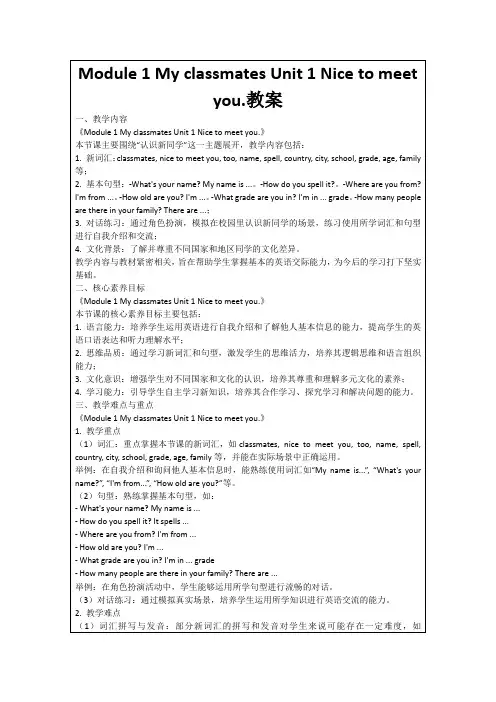
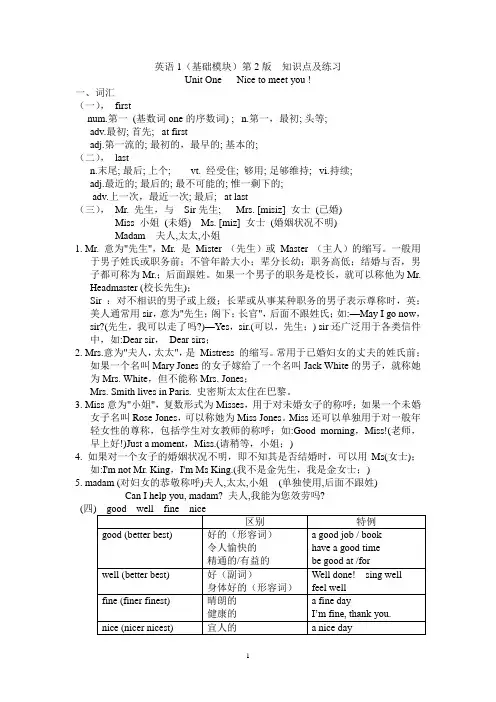
英语1(基础模块)第2版知识点及练习Unit One Nice to meet you !一、词汇(一),firstnum.第一(基数词one的序数词) ; n.第一,最初; 头等;adv.最初; 首先; at firstadj.第一流的; 最初的,最早的; 基本的;(二),lastn.末尾; 最后; 上个; vt. 经受住; 够用; 足够维持; vi.持续;adj.最近的; 最后的; 最不可能的; 惟一剩下的;adv.上一次,最近一次; 最后; at last(三),Mr. 先生,与Sir先生; Mrs. [misiz] 女士(已婚)Miss 小姐(未婚) Ms. [miz] 女士(婚姻状况不明)Madam 夫人,太太,小姐1. Mr. 意为"先生",Mr. 是Mister (先生)或Master (主人)的缩写。
一般用于男子姓氏或职务前;不管年龄大小;辈分长幼;职务高低;结婚与否,男子都可称为Mr.;后面跟姓。
如果一个男子的职务是校长,就可以称他为Mr.Headmaster (校长先生);Sir :对不相识的男子或上级;长辈或从事某种职务的男子表示尊称时,英;美人通常用sir,意为"先生;阁下;长官",后面不跟姓氏;如:—May I go now,sir?(先生,我可以走了吗?)—Yes,sir.(可以,先生;) sir还广泛用于各类信件中,如:Dear sir,Dear sirs;2. Mrs.意为"夫人,太太",是Mistress 的缩写。
常用于已婚妇女的丈夫的姓氏前;如果一个名叫Mary Jones的女子嫁给了一个名叫Jack White的男子,就称她为Mrs. White,但不能称Mrs. Jones;Mrs. Smith lives in Paris. 史密斯太太住在巴黎。
3. Miss意为"小姐",复数形式为Misses,用于对未婚女子的称呼;如果一个未婚女子名叫Rose Jones,可以称她为Miss Jones。
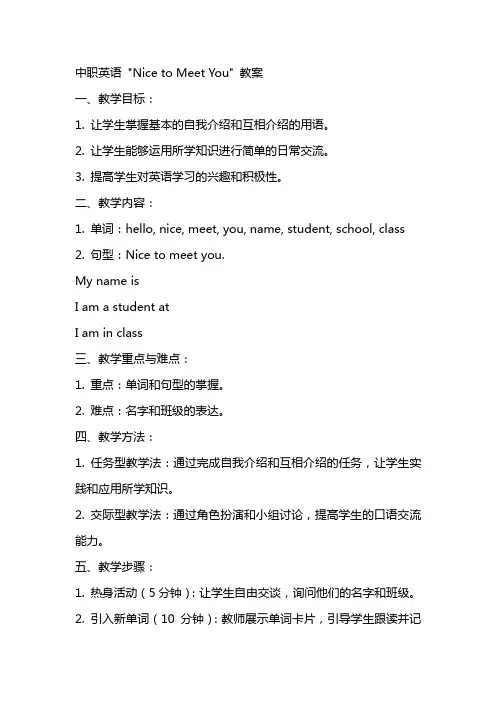
中职英语"Nice to Meet You" 教案一、教学目标:1. 让学生掌握基本的自我介绍和互相介绍的用语。
2. 让学生能够运用所学知识进行简单的日常交流。
3. 提高学生对英语学习的兴趣和积极性。
二、教学内容:1. 单词:hello, nice, meet, you, name, student, school, class2. 句型:Nice to meet you.My name isI am a student atI am in class三、教学重点与难点:1. 重点:单词和句型的掌握。
2. 难点:名字和班级的表达。
四、教学方法:1. 任务型教学法:通过完成自我介绍和互相介绍的任务,让学生实践和应用所学知识。
2. 交际型教学法:通过角色扮演和小组讨论,提高学生的口语交流能力。
五、教学步骤:1. 热身活动(5分钟):让学生自由交谈,询问他们的名字和班级。
2. 引入新单词(10分钟):教师展示单词卡片,引导学生跟读并记忆单词。
3. 句型练习(10分钟):教师给出句型,引导学生进行自我介绍和互相介绍。
4. 小组活动(10分钟):学生分组,进行角色扮演,模拟真实场景进行自我介绍和互相介绍。
5. 总结与作业(5分钟):教师引导学生总结所学内容,并布置作业:写一篇关于自己介绍的短文。
6. 拓展活动(可选):让学生制作自己的名片,进行名片交换活动。
六、教学评估:1. 课堂参与度:观察学生在课堂活动中的积极参与情况和合作精神。
2. 口语表达:评估学生在角色扮演和小组讨论中的口语表达能力。
3. 作业完成情况:检查学生对作业的完成质量,包括语法、拼写和内容准确性。
七、教学拓展:1. 组织一次班级间的英语角活动,让学生在实际交流中运用所学知识。
2. 鼓励学生参加学校举办的英语演讲比赛或英语剧社,提高他们的英语表达能力。
八、教学资源:1. 单词卡片:用于展示和记忆单词。
2. 角色扮演道具:如名片、胸牌等,用于模拟真实场景。
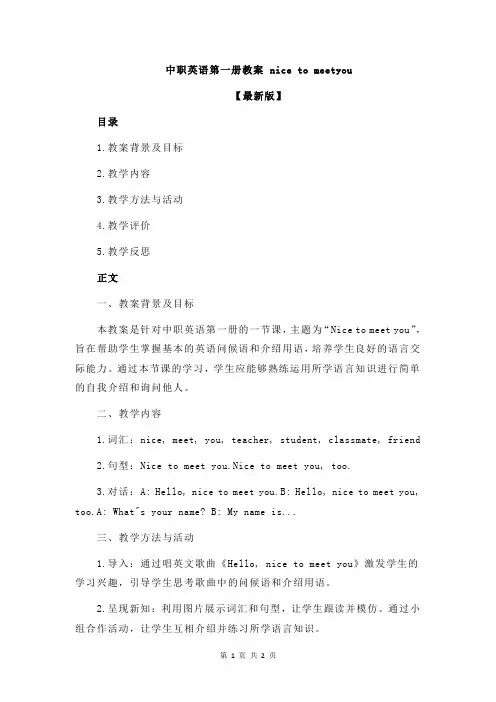
中职英语第一册教案 nice to meetyou【最新版】目录1.教案背景及目标2.教学内容3.教学方法与活动4.教学评价5.教学反思正文一、教案背景及目标本教案是针对中职英语第一册的一节课,主题为“Nice to meet you”,旨在帮助学生掌握基本的英语问候语和介绍用语,培养学生良好的语言交际能力。
通过本节课的学习,学生应能够熟练运用所学语言知识进行简单的自我介绍和询问他人。
二、教学内容1.词汇:nice, meet, you, teacher, student, classmate, friend2.句型:Nice to meet you.Nice to meet you, too.3.对话:A: Hello, nice to meet you.B: Hello, nice to meet you, too.A: What"s your name? B: My name is...三、教学方法与活动1.导入:通过唱英文歌曲《Hello, nice to meet you》激发学生的学习兴趣,引导学生思考歌曲中的问候语和介绍用语。
2.呈现新知:利用图片展示词汇和句型,让学生跟读并模仿。
通过小组合作活动,让学生互相介绍并练习所学语言知识。
3.操练与活动:设置角色扮演活动,让学生模拟不同场景进行自我介绍和询问他人。
利用多媒体展示不同情境下的对话,让学生进行模仿和练习。
4.综合运用:组织学生进行小组竞赛,要求学生在规定时间内向其他组员介绍自己并询问对方信息。
比赛结束后,评选最佳表现小组。
四、教学评价1.学生通过对话练习,能够熟练运用所学语言知识进行自我介绍和询问他人。
2.学生在角色扮演和小组竞赛活动中,积极参与、互动性强,表现出良好的团队合作意识和交际能力。
3.教师在教学过程中,注重启发引导,关注学生个体差异,给予及时鼓励和评价,提高学生学习兴趣和自信心。
五、教学反思1.在教学过程中,要关注学生的发音、语调和语速,引导学生注意语音、语调的正确性,提高学生的口语表达能力。
一、教学目标1 认知目标(1)、新单词和短语:introduce, greet, spell, student, call, vocational, year, secretary, boss, computer ,meet,基本句型:(重点、难点)What’s your / his / her name? How old are you / is he / is she?My / His / Her name is … I am / I’m/ He’s / She’s…years o ld. Where are you / is he / is she / are they from?I’m / He’s / She’s / They’re from…(2)、语法方面:动词be与人称代词的强化(重点、难点)(3)、功能方面:介绍个人信息(4)、语音方面:/i:/ /i/ /e/ /æ /2 能力目标(1)、提高学生听说和读写的能力。
听: 学生能听懂别人的自我介绍。
说:学生能进行自我介绍,并能向别人询问相关的信息如姓名、年龄、职业及来自哪里。
读:学生能看懂不同人的自我介绍的文章。
写:学生能写出他们的个人信息并编造出一个新的信息。
(2)、让学生做到用中感悟,学以致用,把所学的词汇、语法知识运用到真实的交际中,提高学生交际能力。
(3)、培养学生用英语思维的能力及辨析中英文之间的差异的能力。
(4)、开发思维,培养学生的创新精神、合作意识及探究的能力。
3 情感目标通过小组讨论、竞赛及探究性活动等,激发并强化学生的学习兴趣,培养学生乐于与他人合作的品质。
4 文化意识二、学习策略:1、分层指导下的任务设计:面向全体学生,为不同层次的学生提供展示自己才能的机会。
(分层、分组)2、根据学生的兴趣爱好设计活动,在学中玩,在玩中学,让学生在用英语“做事”并解决问题的同时锻炼自己的口语交际能力,即Learning by doing.3、形成性评价贯穿整个课堂,为学生“可持续学习”奠定基础,让学生拥有成就感。
中职英语第一册教案 nice to meetyouLesson 1: Nice to Meet YouAims:- To introduce basic greetings in English.- To practice introducing oneself to others.- To learn some common expressions for making introductions.- To develop listening and speaking skills.Objectives:By the end of the lesson, students should be able to:- Greet and respond to greetings in English.- Introduce themselves using basic information.- Use the expressions "Nice to meet you" and "How do you do?" - Engage in short conversations to get to know their classmates. Materials:- Whiteboard and markers.- Flashcards with different greetings and expressions.- A song or video clip with greetings and introductions. Procedure:1. Warm-up (5 minutes):- Greet the students as they enter the classroom and encourage them to respond in English.- Play a short video clip or song with greetings and introductions to get the students engaged.2. Introduction (5 minutes):- Show the flashcards with different greetings and expressions,and elicit their meanings from the students.- Practice the greetings and responses with the whole class, drilling the pronunciation.3. Introducing Oneself (15 minutes):- Model an introduction by saying "Hello, my name is [your name]." Write the sentence on the board.- Have the students practice introducing themselves in pairs, using the sentence structure.- Circulate around the classroom and provide assistance and feedback as needed.4. Expressions for Making Introductions (10 minutes):- Introduce the expressions "Nice to meet you" and "How do you do?" to the students.- Write the expressions on the board and explain their meanings. - Practice the pronunciation and intonation of the expressions as a class.- Have the students role-play introducing themselves and responding using the expressions.5. Getting to Know You (15 minutes):- Divide the class into small groups and have them sit together. - Give each group a list of questions (e.g., "What is your favorite color?" "Do you have any siblings?") to ask each other.- Encourage the students to introduce themselves and engage in conversations using the expressions they have learned.- Monitor the groups and provide assistance and feedback as needed.6. Wrap-up (5 minutes):- Gather the whole class together and ask a few students to share something interesting they learned about their classmates.- Review the greetings and expressions learned in the lesson, and give positive feedback to the students.Note: This lesson plan is based on a 45-minute class period. Adjust the timings and activities as needed to fit the length of your class.。
中职基础模块一英语教案Unit 1 Nice to meet you!Unit 2 I can do itUnit 4 Welcome to our party!Unit 5 What’s your hobby?课题3.特殊疑问句,特殊疑问词+be动词+主语+……?例如:(1)How many students are there in your school? 你们学校有多少学生?(2)Who is Mr. Green in this photo? 这张照片里谁是格林先生?Step 3: Consolidate and expandActivity 12 Look and write.T asks Ss to make as many sentences as possible. Practice reading these sentences together.Sentence patterns:1.They are students.2.She is a doctor3.She’s/I’m a teacher.4.It’s a bird.5.They’re cats.6.......Activity 13 Talk and guess.Ss work in pairs, one describes each picture, the other guess the person’s job.Activity 14 Write and talk.Ss work in groups. Each student describes one’s favorite super star, then communicate with group members.4.利用图片,尽可能多地写出含有be动词的句子。
5.根据课本图片,两个同学一组,其中一人选择其中一张图片向搭档描述,另一人猜猜选出的是哪一张图片。